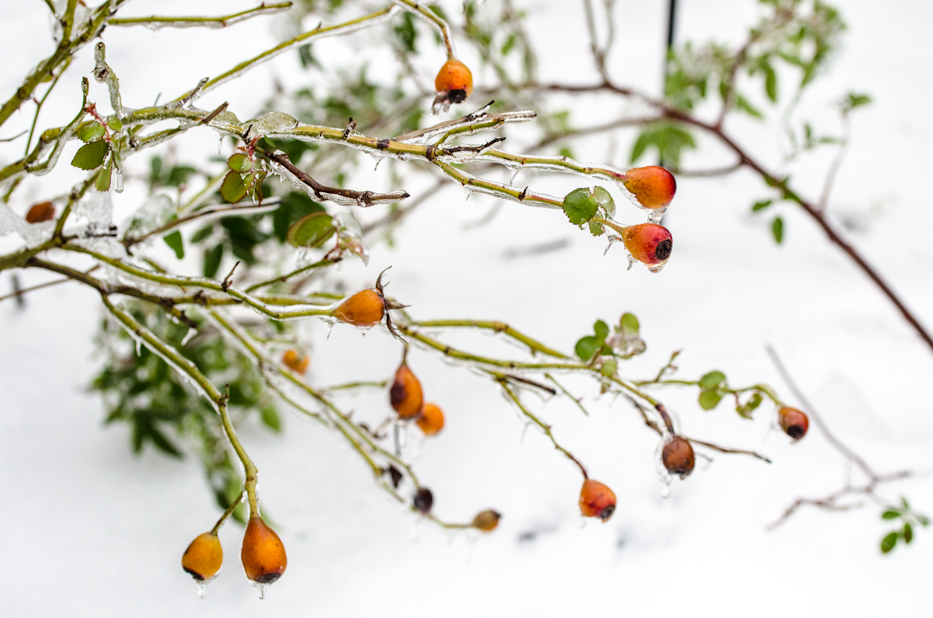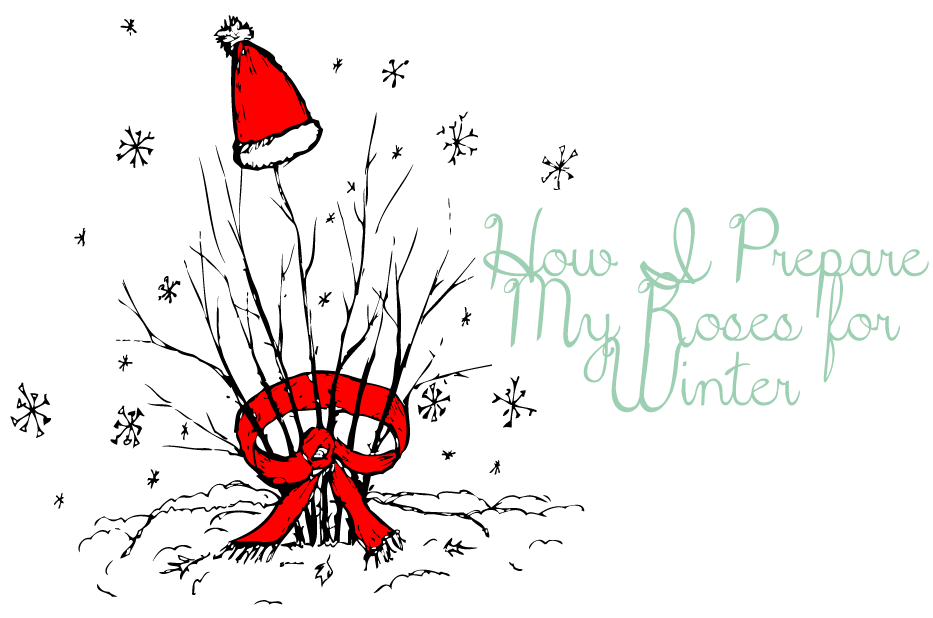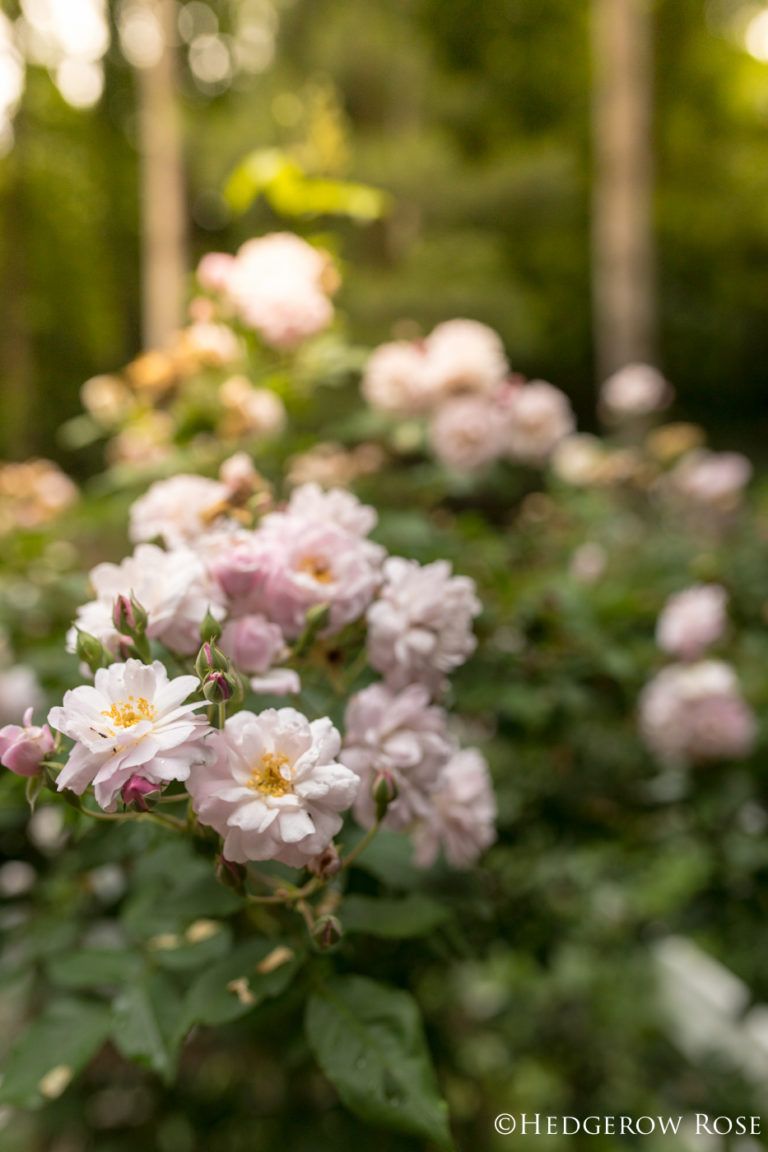How I Prepare My Roses for Winter

{Edited/Updated 2022)

Preparing roses for winter starts as early as the spring by choosing the correct kind of rose for your growing conditions. I garden in an area where winters can get below freezing for extended periods of time so I try to choose roses which are winter hardy to as low as zones 3-4. If you are growing grafted roses (not on their own roots) and you live in a cold winter region, I recommend planting that bud union a few inches below the soil line.
Stop fertilizing and deadheading roses in late summer to tell the rose, “Hey, it’s time to start going into dormancy.”
Clean up and discard diseased debris such as leaves that are afflicted with blackspot or powdery mildew. Actually, you should be doing this during the growing season (and by discard I mean throw out or burn–do not place in your compost bin.) But as winter approaches, chances are your roses are dropping their leaves and it’s best to carefully rake them away from your roses and get rid of them so you’re not harboring any plant diseases over winter.
Check roses for any pests. Don’t forget to check the underside of the leaves where they might be hanging out.
Know your climate pockets I’m sure you’ve noticed that some areas of your garden are more protected from buffeting winds and soak up more sunshine than others. Knowing this will help inform your winterizing decisions.
Should you prune in autumn? I typically prefer to wait until late winter/early spring to prune my remontant roses. That way, I can remove anything that looks damaged by winter and shape my roses accordingly. This is a personal preference and based on where I live in central PA. (OGR’s and other once-blooming roses get shaped immediately after flowering–sometime in June and is a subject for another post.) When I lived in the south, I learned that many gardeners there like to cut their roses back by about 1/3 in autumn in order to prevent “wind-rock” which is when the top heavy roses are literally pulled directly out of the soil by the winter winds. I do not experience that problem here on my clay soil in PA but the soil in my NC garden was sandy and I found that trimming my roses back in the autumn helped to prevent wind-rock.
Climbing Roses
For me, I simply prefer to make sure that my climbing roses are tied in securely and safely and then I prune them in late winter/early spring (see above.) Easy-breezy.
However…
Some gardeners re-tie and shape their climbers in autumn and even prune at this time so the rose is ready to go once spring arrives.
Some gardeners like to remove the canes from supports and and peg to the ground using stakes or “earth staples” if they are concerned about their canes being buffeted by cold winds. Pile up soil, compost and/or mulched leaves on top to make a protective mound, but wait until your rose is in complete dormancy before doing this or you may damage the rose. (After a few hard frosts you should be safe to do this.)
Other safety measures:
Some gardeners loosely bundle and tie the canes on shrub-like roses, such as floribundas, hybrid teas, grandifloras, English roses, etc. to keep them from whipping around and then…
Some gardeners pile up the base of shrub-like roses with soil, compost and/or mulched leaves. Conversely…
Some gardeners build a “sleeping bag” around their roses with chicken wire and backfill with mulched leaves.
What about container roses?
This is the question I get asked the most.
I don’t grow roses in containers as much anymore but here’s what I used to do:
When the weather turns to freezing temps, I bring my container roses into my unheated garage and leave them there until early spring. No, they do not require light (so it’s ok if your garage doesn’t have a window.) No, they will probably not require water during the winter months, but you should water them well before you bring them into your garage and check on them periodically during their dormancy that they didn’t dry out (again, unlikely.) I also like to remove all the leaves first, if they haven’t dropped already, and clean off the top of the soil of any additional plant debris.
Watch the weather in late winter/early spring and try to bring your container roses out when the other roses in your garden are beginning to break dormancy. However, keep in mind that if the weather takes a nasty turn you may need to put them back into your garage until it’s safe to bring them into the garden again.
Spread a layer of compost or mulched leaves on your rose beds in autumn. It will provide an extra layer of insulation to the roots and have all winter to continue improving your soil.





suberb!!! lovely!
Thank you Jacquie!
Nicely said!! Always a good reminder to reread this information!
Thank you Marion!
Finally! Finally I’ve found a website that a novice came make sense of when growing roses in cold climates! I live in Canada and a novice to growing roses. I’ve managed to acquire some cold weather David Austin roses and can happily say they performed splendidly this summer. I’ll follow your advice and cross my fingers. =D
Thank you
Yay! So glad this was helpful to you, Judi! Have you tried growing ‘William Baffin’? It was bred for those cold, Canada winters. I wrote a post about that rose here if you’re interested. Good luck!
Have you tried growing ‘William Baffin’? It was bred for those cold, Canada winters. I wrote a post about that rose here if you’re interested. Good luck!
Question: I planted 2 rose bushes and a petunia plant in a flower bed then covered with wood chips this summer (my first planting experience). All have bloomed beautifully and are still blooming now – almost mid-October and live in Western Wisconsin. Can I just add more wood chips or do you recommend the soil and sleeping bad method you mentioned above for the roses?
Hi Jeanette, thank you for your visit!
Your roses may be just fine without any winter protection at all depending on what climate zone they are hardy to. You can look them up by visiting this link HERE to find out how well they survive winter with/without protection. Good luck!
Thanks for the good information !!
I would like to know that when you bring your roses in to the garage,do they need natural light or can they be kept in the dark ?..
Hi Marsha, thanks for stopping!
I’m not sure how others like to do this, but we keep ours in a garage that receives natural light and I think that helps the roses come out of dormancy in late winter/early spring as the days get longer and the temps increase. Hope this helps!
Thank you for the good info! This will be my first winter with container roses. I live in zone 6b. Could you please tell me when I should bring my roses into the garage? I’ve read elsewhere that you should wait until after a couple of freezes so the roses will go dormant, then put them inside until Spring. However, I don’t want to lose any of my roses during those first two frosts. Should I move them all inside before the first frost or afterward? I just want to give my precious roses their best chance at surviving the winter.
Hi Lesley! Every year I would watch the weather and wait until it started to consistently dip into the low 30’s and then I would bring them in. This was usually sometime in late November/Early December if I remember correctly. There were times, however, when I had to do a quick “get them into the garage!” when we got a freak snowstorm, which once happened as early as October, if you can believe it. I started paring down my container roses when it got to be a bit ridiculous, all that coming and going (I had 60+ at one point so that was a little much.) I hope this answers your question!
Could I bring my potted roses into my sprinhouse during winter? There are three windows or is a garage a better idea?
Hi Erinn! I’m not sure what a springhouse is….but in my experience, it’s best to bring them into a location that isn’t heated. Does that answer your question? Essentially, you don’t want them exposed to those super cold temperatures and icy winds of winter. Placing them in a warm/heated location will make them think it’s time to come out of dormancy, and you don’t want that (unless you have a heated greenhouse which is a whole other topic!) Let me know if there is anything else I can answer for you!
I put compost over my rose base last winter and I got a bit confused as to the planting depth this spring when I uncovered them. Mostly because it was super soggy but time to uncover. Would it be an idea to put a sheet of newspaper flat on the ground around the base before adding compost so you can see where you are at?
I am in zone 6. Is there a rule as to how high to plant root graft? I was told if cold area bury graft Union if warm climate raise it up.
Hi Kelly, that’s a really good question. Most gardeners agree that roses that are grafted should have the bud union planted a few inches below soil level if you live in a climate with cold winters, for example, zones 6 and under. The idea is that that extra layer of insulation around the graft will protect it from the cold and prevent it from dying (allowing the rootstock rose to take over.) If you live in a warmer climate, the bud union can be at or just above soil level. That being said, I personally have never been too persnickety about these measurements. I think the main thing you want to watch is that soil/compost/mulch doesn’t smother the canes too much, causing moisture to build up which might lead to rot. Does that help?
MY CLIMBING ROSES GET EATEN BY VOLES DURING THE WINTER—WHAT SHOULD I DO TO PREVENT THAT ?
Hi Glenn! The (somewhat cheeky) advice I was always given was, “Get a cat.” Well, we have 3 cats but they’re kept indoors to keep them and our songbird population safe. I knew a rosarian who always put his roses in large pots which he then buried into the ground to keep the voles from eating the roots. So that’s an option. Lots of gardeners plant things (like spring bulbs) in cages. That seems like a lot of fuss for me. You may consider planting things around the roses that rodents don’t like the smell/taste of such alliums or fragrant herbs. Hope this helps!